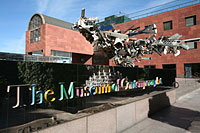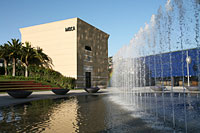
MOCA Grand Avenue
Museums for Sale
Tongues are wagging, heads are shaking. It appears that the highly regarded Museum of Contemporary Art, Los Angeles, is doomed. It has been running a deficit for six of the last eight years. It has been raiding its endowment. And now the plucked chickens, the headless fowls, have come home to roost. MOCA might not be able to go on.
What I want to know is where was the MOCA’s board of trustees when those deficits were reported year after year? Why didn’t the director raise hell? It is all well and good to say that art came before money, but without money the air-conditioning and the lights get turned off. If staff members do not get paid, they walk.
Some nonprofit board members or trustees agree to kinds of bad management they would never tolerate in their own companies; they like to think they are on holiday.
So what are we supposed to do? Cut costs, initiate a hiring freeze, reduce the number of exhibitions. Many museums are already doing this. And then there’s prying loose more money from your board members, who are usually well-heeled and are profiting socially and sometimes financially from their positions. This is L.A. Times art critic Christopher Knight’s solution. But even in good times, this is like getting blood out of turnips.
In the meantime, will anyone match collector Eli Broad’s offer of $30 million toward saving MOCA? Don’t think so. Will it be the end of the world if MOCA is absorbed by the L.A. County Museum? Will art stop if MOCA totally disappears?
Along with the strange idea that successful artists, art dealers, and small Obama campaign-type donations could save the day, Roberta Smith of the New York Times offers this odd reason to keep MOCA independent:
Imagine the effect on New York if MoMA or the Whitney Museum of American Art had been subsumed into the Metropolitan Museum of Art at the age of 30. For one thing, P.S. 1, which has been rejuvenated by its MoMA affiliation, might no longer exist.
And exactly what art space in L.A. will not be “rejuvenated” if MOCA is subsumed by LACMA?
In Artopia we have always looked at the bigger picture.

The Geffen Contemporary at MOCA
A Modest Proposal
In terms of arts institutions, I have not been able to find out or even deduce the cost to taxpayers of the wacky not-for-profit system that allows tax deductions for donations. And if we eliminated these deductions, would we thereby be able to afford better roads, bridges, and universal medical coverage?
But in Artopia we are visionary. Think how much more efficient it would be if museums and other art venues were totally government-funded. Or, on the other hand, if they were for-profit. In both cases, the savings would be enormous.
For instance, a large chunk of any museum budget is development. Development is artspeak for fundraising, begging, or whatever you want to call it. Not only are development officers and their staffs employed to get the money, but curators and, yes, even directors spend a lot of their time soliciting, a term I have chosen with great care.
Most readers understand that grants need to be written and that exhibitions and special projects have to be created to qualify for money from governments, corporations, and foundations. But do readers really know how much time is spent on what in artspeak is called “cultivation,” i.e. just sucking up to potential patrons and donors? Even the amounts derived from membership fees call for the creation and the maintenance of endless perks and far too much face-time. Moving members up a notch to donors requires a mind-boggling array of inane lunches and stupifying gallery tours.
Hasn’t anyone noticed that what donors want is love? I don’t just mean tête-à-tête encounters with the director or access to the charisma and the sexiness of live artists at special openings and, best of all, intimate dinner parties. I don’t mean exhibitions for relatives of board members or the artists they collect. I mean total, floor-scraping, fiendishly servile, always-on-tap, ever-expanding adoration.

MOCA Pacific Design Center
Plan A: The Bail-Out
Museums already pay for themselves. You just have to do the numbers right. And if you do, it might even turn out that they can bring in much more money than they burn up, particularly in big cities. Please figure out tourist dollars. What percent of cab fares, hotel rooms, restaurant dinners are generated by people going to museums? Even locals spend when they go to museums. Lunch? Of course. Not everyone leaves a museum empty-handed: catalogs, postcards, dolls, and all the other art junk on display in logoland migrate from the premises.
And then there is the nasty business of art sales. A particularly tasty exhibition increases the perceived value of all art. And when a living artist is shown, guess what happens to his or her prices in Chelsea? They don’t sink, I’ll tell you that.
The rising tide raises all chips.
There are, of course, other dividends that are incalculable by present methodologies. Museums not only peddle art, they also peddle hope. How many impoverished, sex-crazed, drug-addled adolescents have been saved from a life of crime by the hope engendered by a trip to an art museum? If this drunken bum can become a famous artist, then so can I. Those words are sweet to the ears of art educators everywhere. How many mass murderers have been nipped in he bud by the sight of an Andy Warhol Marilyn? How many addicts have been cured by Sol LeWitt? How many pill-popping housewives have been given a new lease on life by Alice Neel? How much child abuse has been eliminated by the hope conferred by the works and life stories of painters, sculptors, and conceptual artists?

Biltmore Estate
Plan B: Interest Rather Than Conflict of Interest
And now for something different: the for-profit museum.
The fiduciary transparency of for-profit museum drives people in the nonprofit museum world crazy. See, for instance, the current issue of Museum, the official magazine of the American Association of Museums, with its entirely predictable cover story. Oh, yes, for-profit museums (The Sports Museum of America, The International Spy Museum, The Biltmore Estate, etc.) are vulgar; and, by the way, they are not really museums.
And why not? Some even claim to maintain nonprofit museum standards.
But here’s the problem: aura.
According to Artopia, without nonprofit status for-profits do not have the do-gooder aura or the aroma of artistic objectivity. So self-improvement should be for free? Excuse me, self-improvement is an important industry, and I don’t mean only in Los Angeles — where, believe it or not, my entrepreneurial niece is the owner of a “Zen” exercise studio/gym and bills herself as a celebrity trainer.
And the notion that art museums can be artistically objective is nonsense. We know how class, nationalism, economics, sexism, racism influence art history. If the art story is iffy, so are all its products and clients, which includes museums.
Ages ago I took a stab at the for-profit museum concept, but it was disguised as satire. Inspired by the Biltmore Estate in North Carolina, which now charges up to $59 for adults, I had indeed figured out that the non-profit art space I was running on Staten Island, without grants and subsidies of various kinds, would have required an admission fee of $28 per visitor to break even. Costing this out is simple; you divide your budget by the number of visitors. But here the Swiftian waters were muddied by my proposal for The Museum of Itself (MOI), an institution that would document only itself – budgets, minutes of board meetings, et alia – and create exhibitions of same, both temporary and permanent.
Although the idea that an art museum should be totally supported by paying customers may be too radical or even offensive for some, I say what was good enough for P. T. Barnum is good enough for us. We may have substituted dead sharks in tanks of formaldehyde for taxidermy mermaids, but we have not outgrown cabinets of wonders. It’s just that now the wonders range from blank canvases to hypnosis by video art to digital murals and sculptures made of body fluids.
Yet I want to go further. In addition to charging the public the real cost of an exhibition, plus a modest profit for the owners, I propose that for-profit museums also sell shares. These, however, would not be merely shares in the business itself.
You could also buy shares in the output of artists featured at the museum. An exhibition would increase the value of that work, just as it does in a not-for-profit museum, where board members or trustees sometimes own examples of work by the artists whose works are on display. My approach is much more democratic. Anyone could come on board and get a piece of the action.
FOR AN AUTOMATIC ARTOPIA ALERT FOR EACH NEW POSTING
CONTACT: perreault@aol.com
